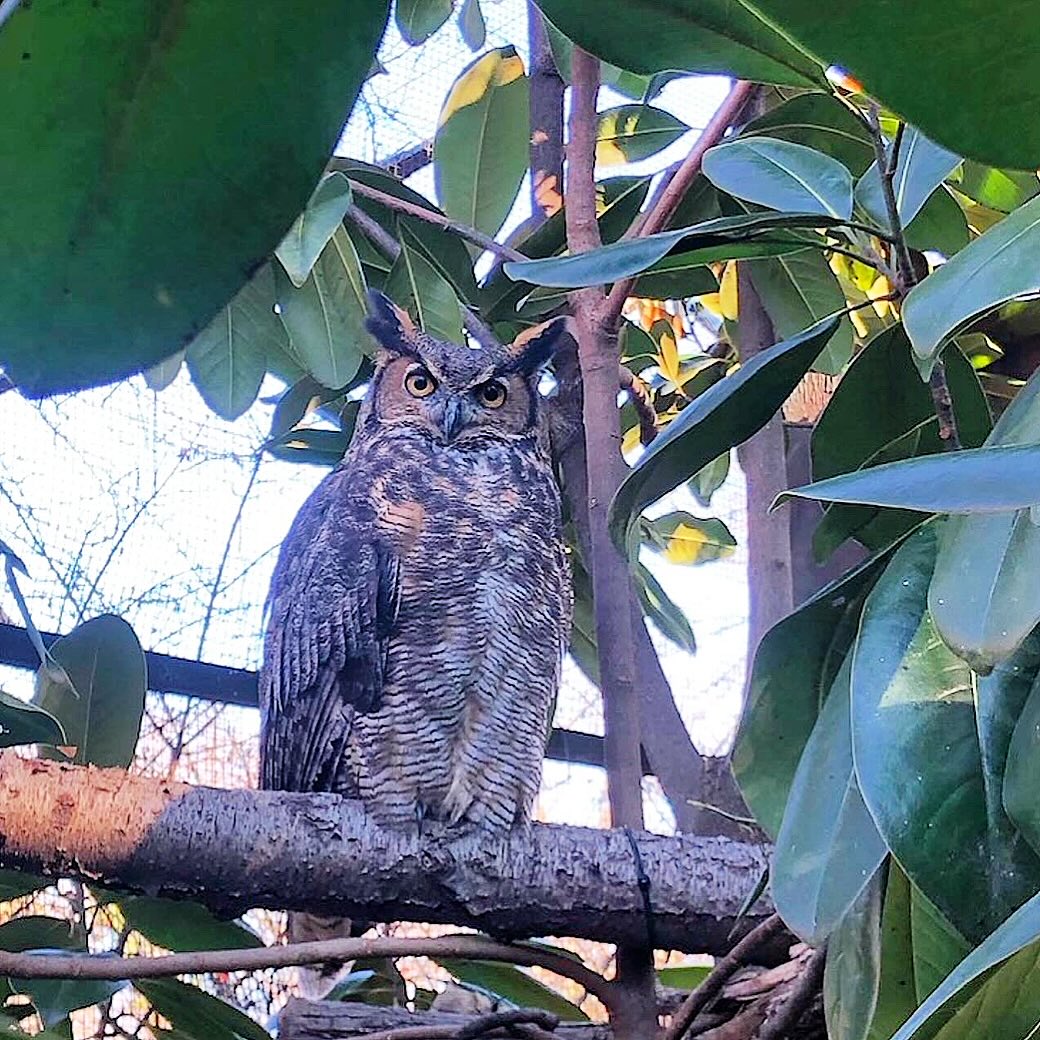- Importance of International Owl Awareness Day
- Features and Behaviors of Great Horned Owls
- Ecological Role of Owls
- Human-Wildlife Conflicts and Solutions
- Conservation Efforts and Public Awareness
Happy International Owl Awareness Day! This special day was created to help raise awareness about our beloved nocturnal raptors. Owls have fascinated humans for centuries, symbolizing wisdom, mystery, and the night. Yet, these birds play crucial roles in their ecosystems and face significant conservation challenges. Today, we’ll focus on the Great Horned Owl, a prominent representative of its family, and discuss various aspects of owl conservation.
One of the stars of Happy International Owl Awareness Day is Hooter, the zoo’s resident Great Horned Owl. Located near the Broadway entrance, Hooter captivates visitors with his majestic presence. Great Horned Owls are named for their distinctive tufted feathers that resemble horns. These birds are renowned for their adaptability and robust hunting capabilities. They feed on a wide variety of prey, including waterfowl, rabbits, squirrels, marsh birds, skunks, and rodents. This diverse diet is indicative of their ecological importance, as they help control populations of species that can become pests to humans and other wildlife.
Great Horned Owls are generalists, capable of thriving in various environments such as forests, swamps, deserts, and even urban areas. Their adaptability has contributed to the stability of their populations, though there have been decreases in some regions. Unfortunately, their tendency to prey on poultry has created tensions between owls and farmers, leading to a clash of interests. However, it is essential to remember that the benefits these raptors provide in controlling rodent populations are immense.
Owls, in general, play a significant role in maintaining the balance of ecosystems. By controlling the populations of small mammals and other prey, they indirectly influence the availability of resources for other predators and species. For instance, when rodent populations are kept in check, there is less competition for food and habitat, benefiting a range of wildlife. Additionally, owls help mitigate the spread of diseases that can be transmitted by rodents, such as hantavirus and plague.
Understanding the ecological role of owls sheds light on the importance of their conservation. However, human-owl conflicts are inevitable, especially in rural areas. Farmers have expressed concerns over owls preying on livestock, particularly poultry. Yet, solutions exist to harmonize the coexistence of owls and humans. Predators like owls can be deterred through the use of protective shelters for poultry, nighttime lighting, and other non-lethal methods. Educating the public about the benefits of owls in pest control can also help reduce animosity towards these birds.
Various conservation efforts are in place to protect owls. Legal protections under the Migratory Bird Treaty Act prohibit the hunting, capture, or sale of owls in the United States. Habitat preservation is another critical aspect. Protecting forested areas, wetlands, and other natural habitats ensures suitable living conditions for owls. Organizations such as the International Owl Center and the World Owl Trust conduct research, rehabilitation, and educational programs to foster owl conservation.
Public awareness and participation are vital components of these efforts. Events like Happy International Owl Awareness Day serve as platforms to educate the masses about the significance of owls. Through educational workshops, birdwatching tours, and interactive exhibits, people can learn about the various species of owls, their behaviors, and their roles in the environment. Furthermore, citizen science projects, such as online databases where individuals can record owl sightings, contribute valuable data to researchers.
In recent years, technological advancements have allowed conservationists to gather more precise information about owls. Satellite tracking and GPS devices provide insights into the migratory patterns and home ranges of these birds. This information can be leveraged to develop targeted conservation strategies and understand the impacts of habitat changes on owl populations.
Climate change poses another challenge to owl conservation. Alterations in temperature and precipitation patterns can disrupt the availability of prey and suitable nesting sites. Conservationists are working to understand these impacts and develop adaptive strategies. For example, providing artificial nests can help support owl populations when natural nesting sites are scarce.
Engagement in owl conservation is not limited to professionals. Individuals can contribute by maintaining owl-friendly habitats in their backyards, such as preserving large trees and installing nest boxes. Reducing pesticide use can also help maintain healthy prey populations for owls. Supporting local conservation organizations through donations or volunteer efforts can amplify the impact of broader conservation initiatives.
Educational institutions also have a role to play. Incorporating owl-related topics into school curricula can inspire the next generation of conservationists. Programs like "Adopt an Owl" in schools can create a personal connection between students and wildlife, fostering a sense of responsibility and stewardship.
In conclusion, Happy International Owl Awareness Day is more than a celebration of these magnificent birds. It’s a call to action for individuals, communities, and organizations to recognize the ecological value of owls and contribute to their conservation. By raising awareness, fostering understanding, and implementing practical solutions, we can work towards a future where owls and humans coexist harmoniously. So, next time you visit the zoo, take a moment to appreciate Hooter and remember the critical role owls play in our world.
*****
Source Description
Happy International Owl Awareness Day!
Today was created to help raise awareness about our beloved nocturnal raptors. Meet Hooter. Hooter is the zoo’s Great Horned Owl that lives in our aviary near the Broadway entrance. Great Horned Owls get their name from the two tufts of feathers on their head that look like horns. Considered by many to be the most voracious of all raptors, these owls feed on an extremely wide variety of prey including waterfowl, rabbits, squirrels, marsh birds, skunks and rodents. Great horned owl populations are currently stable, though a decrease has been seen. There has been some animosity towards these raptors because of their tendency to prey upon farmers’ poultry. However, it should be recognized that the owls are beneficial to humans because they help control rodent populations 🦉


